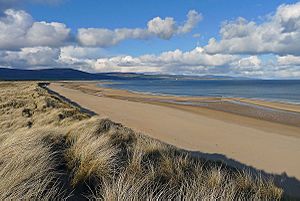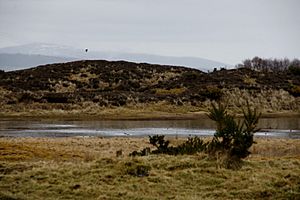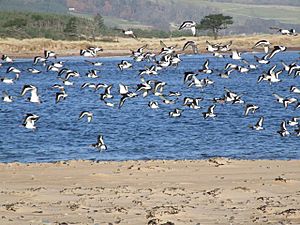Coul Links facts for kids
Lua error in Module:Location_map at line 420: attempt to index field 'wikibase' (a nil value).
Coul Links is a special area of sand dunes located on the east coast of Scotland. It's in a region called Sutherland, between the towns of Golspie and Dornoch. The small village of Embo is just to its south. In Scotland, these sand dune areas are often called "links."
What makes Coul Links so unusual is that it shows a complete natural change from the sandy beach dunes to a coastal heathland. This area also has unique habitats like "slacks" (wet troughs between dunes) and small lakes that appear at different times of the year, called "seasonal lochs."
Coul Links is very important for nature. It's part of several protected areas:
- The Loch Fleet Site of Special Scientific Interest (SSSI)
- The Dornoch Firth and Loch Fleet Special Protection Area (SPA)
- The Dornoch Firth and Loch Fleet Ramsar site (an internationally important wetland)
From 1985 to 2010, the Scottish Wildlife Trust (SWT) helped manage Coul Links. Even though their agreement ended, the SWT still helps manage the nearby Loch Fleet National Nature Reserve.
Contents
Amazing Plants and Animals
Coul Links is home to many different plants. You can find interesting ones like variegated horsetail, purple milk-vetch, rue-leaved saxifrage, moonwort, and frog orchid. The heathland parts of the links also have areas with juniper bushes.
This place is super important for a tiny creature called Fonseca's seed fly. More than 30% of all these flies in the world live here! This fly is only found in the sand dunes along the east coast of Scotland. Coul Links also has several other rare insect species. Sometimes, activities like dog walking, horse riding, or vehicles can disturb birds like terns, which try to nest on the links.
Plans for a Golf Course
In 2015, an American company wanted to build a golf course on Coul Links. This plan would have changed about 13 hectares (about 32 acres) of the sand dune habitat. Many groups that protect nature strongly disagreed with the idea. These included the Scottish Wildlife Trust, Scottish Natural Heritage, RSPB Scotland, Plantlife Scotland, Ramblers Scotland, the National Trust for Scotland, and the International Otter Survival Fund.
Why People Objected
The groups against the golf course said that building it would stop the natural processes that created the links. They worried it would harm the unique plants and animals living there. They also felt it would go against the legal rules for international protected areas like the Ramsar site.
What the Developers Said
The golf course developers argued that their plan would actually help wildlife. They claimed that hunting would no longer be allowed, which would be good for birds. They also said that fewer visitors would disturb the area, especially in winter when the course would be closed. The developers promised to manage the habitat better, which they said wasn't happening at the time. They even offered to buy nearby land to protect it. They also thought the golf course would bring more jobs and tourism to the local area.
However, those who objected questioned if the golf course would really bring the promised economic benefits. They pointed to another golf course built in Balmedie by The Trump Organization. That project didn't create as many jobs or economic benefits as it had promised.
The Final Decision
Highland Council first approved the golf course plan on June 20, 2018. But in August, the Scottish Government decided to "call in" the decision. This meant they would review it at a national level. On February 26, 2019, the government decided to hold a planning inquiry to look into the matter further. Finally, in February 2020, the government's Planning and Architecture Division officially said "no" to the golf course development.




